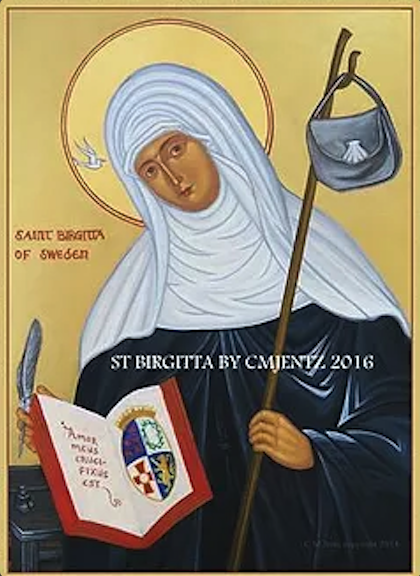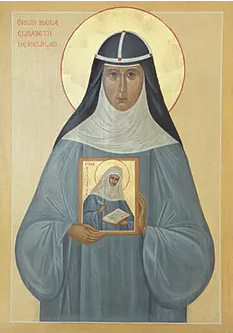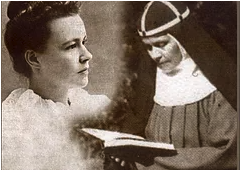St. Birgitta & St. Elizabeth
The Symbol of the Unity of the Church – Saint Birgitta
St. Birgitta of Sweden {St. Bridget) lived in the late Middle Ages which was marked by fighting and divisions from unending fratricidal war, economical and political madness, from religious divisions and threats of schism in the same Catholic Church. Bridget was a spirit of reconciliation and of peace. Because of the origin of her lineage, her permanence at the royal court of Sweden as counselor in the reigning government and trips in the various European nations, it brought her the knowledge of the problems associated with diplomacy, politics and governing the people. That allowed her to understand Europe’s situation and the problems of the Church, which were squandered so that the Pope left Avignone and returned to the seat of Rome.
She worked untiringly for peace in Sweden, France, Italy and England that was pulled apart by factions, revolts and wars. The simple prayer that poured out from her lips that she had lived in fullness was: “God, show me your way and arrange it that I may be happy to follow you.”
May it be still possible for this woman, wife and mother, great Mystic of the North, to show us the true way to be covered by speeding up the hour of unity.
St. Birgitta is the co-patroness of Europe.


A Life Devoted to Unity – Our New Saint : Saint Elizabeth Hesselblad
Elisabeth Hesselblad born in Sweden of Lutheran denomination emigrated to America in order to economically help her family. In contact with the suffering and illness of which she had experienced as a nurse at Roosevelt Hospital where she worked, Elisabeth went about acquiring her spiritual and human feelings conforming to that of her compatriot St. Bridget, based solely on the love of the Crucifix by which she was obligated by her own realization of the unity of all humanity.
She converted to the Catholic faith on August 15, 1902. After several obstacles and serious illnesses, she donned the Bridgettine habit in the House of Saint Bridget in Rome, then occupied by Carmelite nuns. Under the inspiration of the Holy Spirit, she founded the new branch of the Bridgettine order. This new branch deep-rooted in the ancient Bridgettine base had its beginning on September 18, 1911, and was approved in a definite way by the Holy See on December 2, 1940.
The establishments of Mother Elisabeth is present today in Europe (Sweden, Finland, Estonia, Poland, England, Switzerland, Italy), Asia, India, America, Mexico, and the United States). On July 5, 1988, the Ecclesiastical Tribunal Vicariate of Rome introduced the cause of beatification of Mother Elisabeth as the Servant of God. She died in Rome April 24, 1957, and left the profound record of an exceptional woman, filled with the spirit of humility, charity, great faith, and credible testimony of the values of John Paul II for the society of our times.
We must nourish a great love for God and our neighbors; a strong love, an ardent love, a love that burns away imperfections, a love that gently bears an act of impatience, or a bitter word, a love that lets an inadvertence or act of neglect pass without comment, a love that lends itself readily to an act of charity.

Canonization in 2016
What Every Catholic Should Know About St. Marie Elizabeth https://youtu.be/apj1USRk1GQ?si=wI4zEXso5JcukqPe
YouTube of Mass
Holy Mass and Canonization of Stanislaus Papczyński and Maria Elizabeth Hesselblad – 2016.06.05
https://www.youtube.com/watch?v=dwkP3J_6ew8
Appeal for Unity in the Third Millennium
The twentieth century of the Christian era, marked by the collapse of the walls of ideologies was strongly marked by many conflicts, two World Wars and the terrible atomic bomb. The dawn of the third millennium was not able to accept the message of Saint Bridget and our today’s Mother Teresa: two women who had given their lives for unity.
St. Bridget’s message calls up the responsibilities of nations, the politicians, the scientists, men and women of culture, and clergymen to consider the human adventure in terms of communion and of unity:
-
political unity in economic collaboration, in the division of assets, and
-
unity of believers as in a final word of peace between people and nations.
It is this attitude that Bridget’s children want to contribute to the dawn of the third millennium, with the gift of their life and testimony of an evangelical message directed to whoever, with sincerity, seeks peace.
